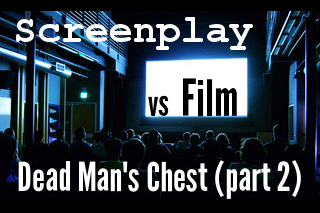Today’s screenwriting tips are a continuation of yesterday’s post Screenplay vs Film: 7 Screenwriting Tips from Pirates of the Caribbean-Dead Man’s Chest. Remember, every Tuesday (mostly), I’ll share what I learned by comparing the screenplay and film versions of popular movies, so this Screenplay vs Film series should produce a nice collection of practical screenwriting tips for your to review at your leisure. We’ll start with…
Screenwriting Tip #4: Creating a catchphrase
The aspiring screenwriter’s dream goes a little like this: make a million dollar spec sale, quit the day job, and sail the Mediterranean in a yacht once owned by a Russian oligarch (who moved on to a larger model). Behind that dream, is another–that something we’ve written finds its way into pop culture. The best line in Dead Man’s Chest (in my opinion) gives us a little insight on how to do that. That line is…
Where’s the thump-thump?
It’s a brilliant, deliciously onomatopoeic line, an instant classic…and it wasn’t in the original screenplay.
In the pre-production draft, Captain Jack merely inquired, “where’s the heart?” The difference between the two lines shows how one phrase can fade into oblivion while the other can become a catchphrase, quoted long after the movie’s been seen.
So what’s the big difference? “Where’s the thump-thump?” is a line that only Captain Jack Sparrow would say. Several thousand other people–real or fictional–would have examined the broken jar and the sand scattered across the ship deck and asked, “where’s the heart?” Only Jack Sparrow would have asked, “where’s the thump-thump?”
What about that famous catchphrase “I’ll be back” from Terminator 2? It’s a run of the mill expression, said by characters in hundreds of movies made prior to T2. But its meaning is certainly anything but mundane within the context of the thriller’s plot. Now I have to admit, delivery’s a part of creating classic lines too. Arnold’s particular delivery of “I’ll be back,” likely his only positive contribution to society, made it a classic. In POTC 2, Johnny’s infusion of half-mad desperation certainly adds to his line.
You can’t control an actor’s delivery in your screenplay. But if you write a line of dialogue that encapsulates your movie’s plot and is phrased in a way that only your character could come up with, you’re well on your way to making an addition to the popular lexicon.
Screenwriting Tip #5: Give the audience credit
The dice game that Davy Jones’s crew played was one of my favorite scenes in the script and the movie. Interestingly, this game, Perudo, found its way into the script after screenwriter Terry Rossio and director Gore Verbinski drank wine together and played it late into the night…
The interesting thing is that in the pre-production screenplay, there was a game between Will and Davy Jones BEFORE their showdown in which Will Turner’s dad gambles his soul to Jones in order to save Will.
WILL
Any member of the crew can be challenged?
BOOTSTRAP
Aye, anyone.
WILL
I challenge Davy Jones.
All crew members within earshot are shocked. The sound of BOOTS on the deck above. Crewmen part…and JONES is there.
DAVY JONES
Accepted.
EXT. FLYING DUTCHMAN – MAIN DECK – DAY
A space is cleared on deck. A barrel is rolled up and crates set down. Will and Davy Jones sit opposite, each with a cup of dice.
WILL
I wager everything I own.
DAVY JONES
I only bet for what’s dearest to a man’s heart. Else there’s no way to tell if he’s bluffing. What a man is willing to risk, or not risk–that is a measure of his soul.
WILL
I wager a hundred years of service.
Bootstrap Bill is shocked.
BOOTSTRAP
No–
DAVY JONES
Against your freedom?
WILL
My father’s freedom.
DAVY JONES
Agreed.
{They play a round of Perudo. Will wins, then asks Jones for another round.}
This match totally unnecessary, and it’s a good thing they cut it. The audience already witnessed the game being played by Jones’s crew. They also heard Will give a quick rundown of the rules. That’s enough–the audience doesn’t need to see a “dry run” before the important match is played.
One of the best parts of the movie is when Will asks if anyone can be challenged, then follows that up with “I challenge Davy Jones.” That scene beat was so full of tension, suspense and drama–which got frittered away when Will and Davy Jones played their dry run round.
At first, 100 years of service may sound like a lot, but in the grand scheme of eternity, it’s a drop in the bucket, like a billionaire betting $100 grand. They aren’t real stakes…so playing for them drains away your story’s drama instead of adding to it.
An eternity of servitude against the key to the chest containing Jones’s heart. Now, those are stakes. It’s clear to the audience that each player had a lot on the line, so even if they only had a fuzzy idea of how the game was played, they still were in suspense about the game’s outcome.
Give the audience some credit. They don’t need everything spelled out for them. In fact…
Screenwriting Tip #6: Leave a little unsaid
This screenwriting tip is closely linked to #5, but it’s not quite the same. With the Perudo dice game, some explanation is needed, and the audience gets that through Will’s observations. Here’s an example, where none is needed at all:
Beckett approaches the bag. He peers inside. Closes it up.
BECKETT
Remarkable.
NORRINGTON
Then I’ve won commission as a privateer.
BECKETT
Better…Reinstatement to your former rank and status, all rights and privileges attendant. And I believe a promotion is due, as well. Do you agree, Admiral Norrington?
Norrington is overwhelmed–and then with military precision draws the sword, rests it over his left arm, point aimed at the heart.
NORRINGTON
Give the order, sir.
BECKETT
Oh no, no, no. No. That would be terribly imprudent. Where is the profit in killing Jones when we can instead add another ship to your fleet?
Norrington looks at him quizzically.
BECKETT (CONT’D)
The Flying Dutchman.
He opens the doors. Beyond, people on the dock stare at–
THE FLYING DUTCHMAN, moored in port. Jones’ crew line the rail. Jones, at the wheel, looks up toward Beckett, inclines his head in salute.
BECKETT (CONT’D)
Whoever controls the heart of Davy Jones, controls the sea.
Don’t remember that in the movie?
You shouldn’t, because it was cut. And it plays so much better that way.
We’ve seen that Beckett is an unsavory businessman. He arrested Will and Elizabeth on their wedding day, and his second-in-command killed an honest captain loyal to the Governor in cold blood. We know the wicked power of Davy Jones. He feasts on the pain of desperate men before they die, and enjoyed watching Mr Turner whip his own son. We understand that whoever holds Jones’s heart controls the sea–Gibbs said it point blank, plus no navy is a match for a ghost ship helmed by men who can’t be killed…when you add all of that up, we know Beckett getting Jones’s heart is a very bad thing.
There’s a little satisfying thrill in putting together all of those pieces in that instant when Norrington dumps the “thump-thump” on Beckett’s desk. A thrill which the audience can’t experience if the pieces are put together for them. Sometimes, a brief explanation is needed…like when Sherlock Holmes wrapped up loose ends and told Watson and Mary how Lord Blackwood escaped from his tomb..but sometimes, it’s best to leave a little unsaid.
And less of a screenwriting tip and more of a spot of encouragement:
Aspiring screenwriters often wonder after several hours lovingly (occasionally hatefully) revising their screenplay, “is it good enough?” It’s a very anxiety-provoking question and one screenplay vs film difference might provide an answer.
You already know about the Black Pearl’s crew being trapped in cages made of bones and how they escape. While all of that is going on, Jack Sparrow is also trying to escape from the cannibals. Although considered the king of the cannibal tribesmen, they want to kill him (to release his spirit).
So they’ve tied him to giant bamboo spit above an unlit pyre. He manages to escape being burned above the pyre, but can’t wrestle free of the spit. To take him down, some cannibals throw an assortment of tropical fruits at him–and they end up speared by the spit, a giant fruit kabob. Jack uses the spit to pole vault across a gap between two cliffs…eventually escaping the cannibals and reuniting with his crew.
One of my favorite parts of the movie is the whole fruit kabob scene, brief as it may be. That moment of humor in the middle of action, adventure, and danger is pure box office gold…but it wasn’t in the pre-production screenplay. It got added during filming–maybe Terry and Ted got the idea on set or maybe one of the crew (Johnny perhaps?) suggested it.
The point is that even without the fruit kabob part which is AWESOME, the script was definitely good enough. Why? Because it took the “escape from people hellbent on killing you” sequence which we’ve all seen in hundreds, if not thousands of movies, and presented it in a way we had never seen before. Really, when’s the last time you saw a hero escape certain death by pole vaulting with a giant bamboo spit?
Your screenplay will be decent if it has original characters and an original story, but even in original stories, heroes participate in the same basic actions–chasing the bad guys or escaping them, for example. When you write those scenes in a way that hasn’t been seen before, then your screenplay is definitely good enough…and you just might be worthy of the “A-List” epithet.
Final thoughts
You’re probably thinking that the differences between the pre-production draft of Dead Man’s Chest and the movie you saw in the theater were so minuscule as to be irrelevant. But those tiny changes mark the difference between a decent screenplay and a summer blockbuster that appeals so much to all four quadrants, it rakes in a billion dollars worldwide.
If commercial success is what you speak, then studying these minute differences is invaluable. Even if you’re not so financially ambitious, Pirates of the Caribbean 2 is a great screenplay to study if you’ve got a solid understanding of character, plot, and screenplay description & dialogue, and want to learn screenwriting tips to take your screenplay to that next level…
Watching a blank screen (with modifications) by Kenneth Lu




















